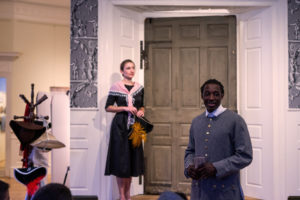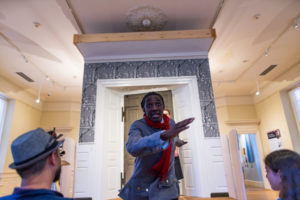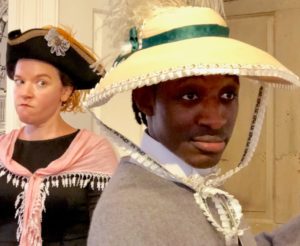
(Marge Dunn and Stephen Sampson)
by Michael Cox
John Hancock. A wealthy politician with a criminal past. A beloved statesman and a Founding Father whose name would resonate through history.
This is the story of the woman and the enslaved person that lived under his roof, people who hovered in the limelight of his passionate democratic ideals and yet had no rights or political voice of their own.
Sounds like a pretty interesting play, doesn’t it? But that’s not what the play Cato & Dolly is actually about. It’s a series of vignettes centered around a door.
To be fair, it’s a pretty old door. This door stood on the Hancock Mansion until it was demolished in the mid 1800s. The great man saw and passed beside the door nearly every day. He passed through its threshold. He didn’t touch it however. He had slaves to open his door for him.
The door, the actual object, is part of an exhibit called Through the Keyhole, now on display at the Old State House, and the very door is used in this 20-minute play, running 9 times a week, around midday, through September 29.

(Stephen Sampson)
The Bostonian Society, the people who preserve and maintain the Old State House as a historical site and museum, have once again commissioned a play by local playwright Patrick Gabridge. They did this once before with Gabridge’s play Blood on the Snow, a full-length play that chronicled the hours after the events we know as the Boston Massacre.
In Cato & Dolly, two actors play the slave, Cato, and John Hancock’s wife, Dorothy Hancock, as well as host of accompanying characters, as they pass through a pretty extensive period of time. Along the way, we see John Hancock’s hang-ups with flatware, Dorothy’s personal grief, and Cato’s choice to keep working for a man who once enslaved him.
At the exhibit, you’ll see a number of artifacts from the now-destroyed Hancock Mansion. Becca A. Lewis uses these amazing artifacts (mostly the door) to evoke the spirits of Boston’s rich history. The ghosts of so many lives whisper through the wood of this entryway. Voices that were never recorded, voices that were never written down, voices that can now only be heard by way of a medium or an artist, and Lewis takes her responsibility seriously. At one moment she sets the Hancock house rolling with her bombastic portrayal of a cantankerous John Hancock suffering from gout; then, moments later, she is Dolly again lamenting the loss of her child, her countenance decimated, her eyes filled with tears.

(Becca A. Lewis and Stephen Sampson)
Stephen Sampson stands out when he is not playing Cato. His skills are manifest in the character roles. Cato is a personality that really ought to be given a voice. Of course, we really don’t know how this historical figure felt or behaved, especially in his private moments. We know a few facts about him, and the rest is speculative. Gabridge chooses not to speculate very far. Rather than imagining details, Gabridge sticks pretty close to the record. It feels authentic, but it doesn’t feel very personal or interesting. This is compounded by the fact that Cato is always around white people, so his behavior is inhibited.
(On alternating performances the role of Dolly is also played by Marge Dunn and Margaret Clark and the role of Cato is also played by Felton Sparks.)
Director Courtney O’Connor shapes the smallest moments into the most significant events. In one of these, Dolly accepts an invitation to share some chocolate with an admirer (Hancock has passed on). In a few simple words, volumes of passion, apprehension, and anticipation are communicated.
Sadly, these moments pass quickly. For instance, the wooing of the Hancock widow: the moment happens suddenly, we are charmed, and then the narrative is over as soon as it began. The play can best be described as a lot of historical information. One would hope with its title this play would have more to do with the relationship between its title characters. Instead, it’s a series of scenes that lack a compelling dramatic arch. It comes right out of the gate with a couple of long, exposition-filled monologues, and though it does pick up from there, it never achieves a unified, gripping narrative.
On the up side, this theatrical presentation and the exhibit are free with the price of admission to the Old State House. And anyone 18 and under can see the play for free, although those under 16 must be accompanied by an adult. For more information, go to: https://www.bostonhistory.org/cato-dolly/

